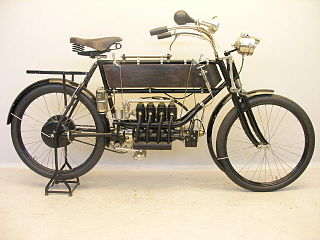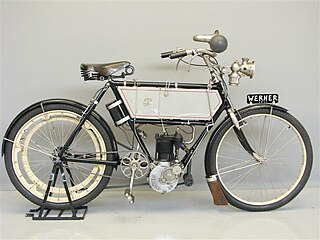
A motorcycle, often called a motorbike, bike, or cycle, is a two- or three-wheeled motor vehicle. Motorcycle design varies greatly to suit a range of different purposes: long-distance travel, commuting, cruising, sport including racing, and off-road riding. Motorcycling is riding a motorcycle and related social activity such as joining a motorcycle club and attending motorcycle rallies.

A motorized bicycle is a bicycle with an attached motor or engine and transmission used either to power the vehicle unassisted, or to assist with pedalling. Since it always retains both pedals and a discrete connected drive for rider-powered propulsion, the motorised bicycle is in technical terms a true bicycle, albeit a power-assisted one. However, for purposes of governmental licensing and registration requirements, the type may be legally defined as a motor vehicle, motorbike, moped, or a separate class of hybrid vehicle.
This timeline of motorized bicycle history is a summary of the major events in the development and use of motorized bicycles and tricycles, which are defined as pedal cycles with motor assistance but which can be powered by pedals alone.
The history of the motorcycle begins in the second half of the 19th century. Motorcycles are descended from the "safety bicycle," a bicycle with front and rear wheels of the same size and a pedal crank mechanism to drive the rear wheel. Despite some early landmarks in its development, the motorcycle lacks a rigid pedigree that can be traced back to a single idea or machine. Instead, the idea seems to have occurred to numerous engineers and inventors around Europe at around the same time.

The Pierce Four was the first four-cylinder motorcycle produced in the United States. The model is included in the AMA Motorcycle Hall of Fame Classic Bikes and Barber Vintage Motorsports Museum. Touting its inline-four engine as "vibrationless", Pierce sold the motorcycle for $325, rising to $400 by 1913, which was expensive at the time, making it popular with "more prosperous sportsmen".

The Art of the Motorcycle was an exhibition that presented 114 motorcycles chosen for their historic importance or design excellence in a display designed by Frank Gehry in the curved rotunda of the Frank Lloyd Wright-designed Solomon R. Guggenheim Museum in New York City, running for three months in late 1998. The exhibition attracted the largest crowds ever at that museum, and received mixed but positive reviews in the art world, with the exception of some art and social critics who rejected outright the existence of such a show at an institution like the Guggenheim, condemning it for excessive populism, and for being compromised by the financial influence of its sponsors.
Italjet Moto Srl (Italjet) is an Italian manufacturer of motorcycles, headquartered in Castel San Pietro Terme, Bologna, Italy. The company was founded in 1959 in San Lazzaro, Bologna by Leopoldo Tartarini.

The Michaux-Perreaux steam velocipede was a steam powered velocipede made in France sometime from 1867 to 1871, when a small Louis-Guillaume Perreaux commercial steam engine was attached to a Pierre Michaux manufactured iron framed pedal bicycle. It is one of three motorcycles claimed to be the first motorcycle, along with the Roper steam velocipede of 1867 or 1868, and the internal combustion engine Daimler Reitwagen of 1885. Perreaux continued development of his steam cycle, and exhibited a tricycle version by 1884. The only Michaux-Perreaux steam velocipede made, on loan from the Musée de l'Île-de-France, Sceaux, was the first machine viewers saw upon entering the Solomon R. Guggenheim Museum rotunda in The Art of the Motorcycle exhibition in New York in 1998.

The Roper steam velocipede was a steam-powered velocipede built by inventor Sylvester H. Roper of Roxbury, Boston, Massachusetts, United States sometime from 1867–1869. It is one of three machines which have been called the first motorcycle, along with the Michaux-Perreaux steam velocipede, also dated 1867–1869, and the 1885 Daimler Reitwagen. Historians disagree over whether the Roper or the Michaux-Perreaux came first. Though the Reitwagen came many years later than the two steam cycles, it is often labeled as the "first motorcycle" because there is doubt by some experts whether a steam cycle should meet the definition of a motorcycle.

Sylvester Howard Roper was an American inventor and a pioneering builder of early automobiles and motorcycles from Boston, Massachusetts. In 1863 he built a steam carriage, one of the earliest automobiles. The Roper steam velocipede of 1867–1869 may have been the first motorcycle, for which he was inducted into the Motorcycle Hall of Fame in 2002. He is also the inventor of the shotgun choke and a revolver repeating shotgun.

The Daimler Petroleum Reitwagen or Einspur was a motor vehicle made by Gottlieb Daimler and Wilhelm Maybach in 1885. It is widely recognized as the first motorcycle. Daimler is often called "the father of the motorcycle" for this invention. Even when the three steam powered two wheelers that preceded the Reitwagen, the Michaux-Perreaux and Roper of 1867–1869, and the 1884 Copeland, are considered motorcycles, it remains nonetheless the first petrol internal combustion motorcycle, and the forerunner of all vehicles, land, sea and air, that use its overwhelmingly popular engine type.

The NS motorcycle, made by Narazo Shimazu in 1909, was the first motorcycle to be designed, built and sold in Japan. Shimazu created the Nihon Motorcycle Company (NMC) to manufacture the NS. In 1926 he then produced another new motorcycle design, the Arrow First. The earliest motorcycle that the Society of Automotive Engineers of Japan (in Japanese) includes on its list of the 240 Landmarks of Japanese Automotive Technology is the 1909 NS.

The Copeland steam bicycle was a steam powered, two-wheeled motor vehicle made by Lucius Copeland in 1881 and is sometimes classed as an early motorcycle.

The Auto-Bi was an early motorcycle made by the Thomas Motor Company in Buffalo, New York. According to many sources, it was the first motorcycle widely available for sale in the United States.

The Curtiss V-8 motorcycle was a 269 cu in (4,410 cc) V8 engine-powered motorcycle designed and built by aviation and motorcycling pioneer Glenn Curtiss that set an unofficial land speed record of 136.36 miles per hour (219.45 km/h) on January 24, 1907. The air-cooled F-head engine was developed for use in dirigibles.

The FN Four was the world's first production inline-4 motorcycle, manufactured in Liége by Fabrique Nationale from 1905 until 1923. It was also, at 40 miles per hour (64 km/h), the world's fastest production motorcycle from 1911 until 1912.

The New Werner was a motorcycle produced by Werner Motors beginning in 1901. It replaced Werner's 1897 model, whose motor placed above the front wheel caused handling problems. Production ceased in 1908. Some 50, now known as the "Leitner Rossiya Motorcycle", were also produced under license in Russia with Fafnir engines at the Riga bicycle works.

Hazlewoods Limited of Coventry were manufacturers of bicycles from 1895, and motorcycles from 1911 until closure c. 1923. They were typical many British companies who proceeded from bicycle manufacture to motorised bicycles, a change made possible by engine and geared hub suppliers.
Sears Dreadnought was a motorcycle sold by Sears in the 1910s. The motorcycle featured a 70.62-cubic-inch (1,157.3 cm3) V-twin made by Spacke. It was sourced from Spacke's cyclecar and had 9 horsepower (6.7 kW). This engine was also used by Dayton, Eagle, Minneapolis and Crawford. In addition to the internal combustion engine, it also had foot-pedals like a regular bicycle.
















